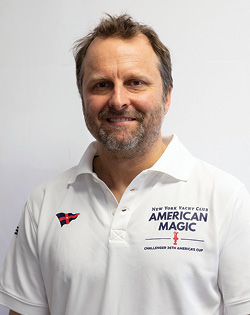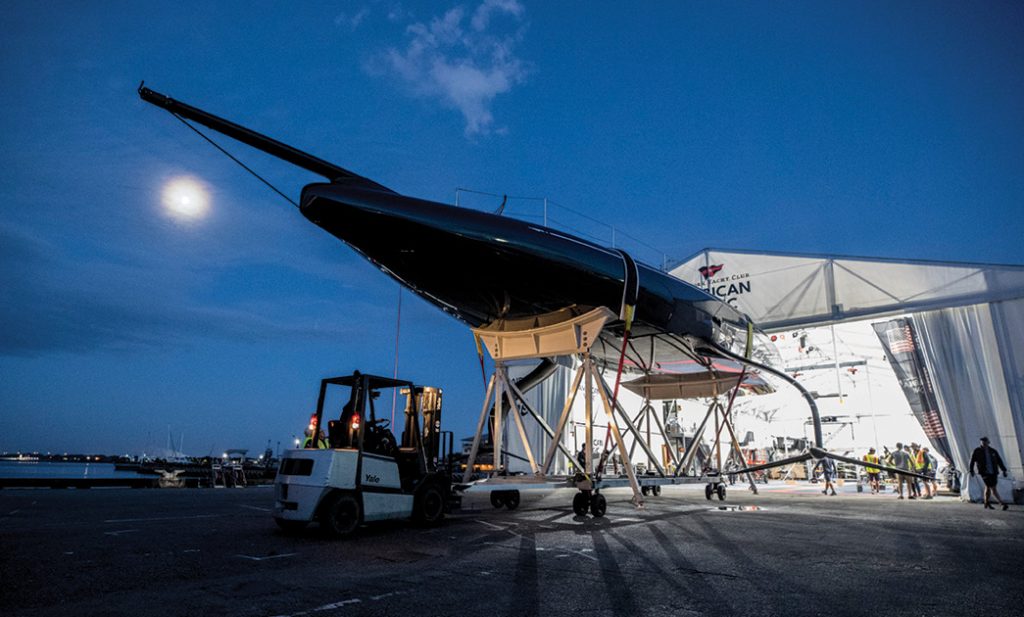
Brandon Linton © Amory Ross/American Magic
A specialist in the construction of composite boats, structures and components since 1990, Brandon Linton has worked with many of the world’s foremost yacht designers and engineers. His CV includes the management and construction of two Volvo Open 70s (the Juan Kouyoumdjian-designed Mar Mostro and the Botin/Carkeek-designed Il Mostro for PUMA Ocean Racing); the Verdier/VPLP-designed Comanche, Jim Clarke’s record-smashing 100-footer; the AC50 Magic Blue for Artemis Racing in the 35th edition of the America’s Cup; eleven America’s Cup class yachts and more than a dozen other grand prix racing yachts. As Boat Construction Manager with New York Yacht Club American Magic, challenger for the 36th America’s Cup presented by Prada, he’s in charge of the construction of the team’s 38-foot foiling test boat and a pair of foiling AC75 yachts.
WindCheck: Where did you grow up, and how old were you when you started sailing?
Brandon Linton: I grew up on the Northern Beaches of Sydney and Gold Coast, Queensland, Australia. My father was the reason I became involved in the boating community. He was the Vice Commodore of The Royal Motor Yacht Club on Sydney’s Pittwater, and also the Race Director for the club’s weekly ‘Twilight Series’ yacht race which would have in excess of 100 yachts at the start-line every Monday night. I was involved in this weekly racing as a teenager with a couple of mates on an extremely slow 30-foot cruising yacht. We didn’t take the racing too seriously. My father gave me a 12-foot open fishing boat with a tiller steer outboard when I was 15. Looking back, it was a great way to learn about responsibility and independence on the water, plus it was a lot of fun.
WC: What inspired you to become a composite boatbuilder, and where did you acquire your skills?
BL: I was always building things from a very young age. I always had a project on the go. I was into boating and so it all sort of made sense to build boats. I really wanted to build timber boats at that time but that art was dying out. I started my boatbuilding apprenticeship building production powerboats for Riviera Marine in Queensland at the age of 18. At two years into a four-year apprenticeship, I realized that I wanted to get more out of this trade by building more high-tech craft out of more high-tech materials, so I transferred my apprenticeship to McConaghy Boats in Sydney. I have to give thanks to John McConaghy who took me on at the height of an economic recession, which placed me on the pathway to where I am today. I’ve had the privilege of working with some of the most influential designers, engineers and builders in the industry, whose shared knowledge has helped my decision making throughout my career.
WC: Please describe the services you provide for the management and construction of composite race boats.
BL: It depends on the client’s requirements. Usually it’s to allow the client to have more control over the construction and the final product when compared to a typical build in an existing boatyard. I’ll usually assemble a build team or supplement an existing one, fit out a build facility for composites construction if required, liaise with designers and engineers to choose materials and construction methods, create and manage a build schedule, and create and implement construction and quality control procedures. [My responsibilities include] daily management of the build team and construction of the vessel, and of course maintaining the completion date. I also like to get on the tools whenever possible.
WC: Please tell us about some of your earlier projects, particularly Comanche, Mar Mostro and Il Mostro.
BL: I’ve been lucky to build some really cool boats in many places around the world. Comanche, Mar Mostro and Il Mostro were built in New England, so building American Magic’s boats in Rhode Island is not at all foreign to me. Mar Mostro and Il Mostro were Volvo 70s, and they were great boats to build. I was sorry to see the Volvo 70s replaced by one-design yachts, as I found the design and build component to be part of the race. Comanche was a 100-foot beast to build in very little time. We had to rethink everything due to the size and in particular her beam. I was contacted by Ken Read and Kimo Worthington to build those three yachts and so that was the connection with New England. Several other people helping to build American Magic’s yachts were involved with these projects as well.

New York Yacht Club American Magic’s AC75 Defiant is removed from her shed at the team’s winter base in Pensacola, FL during the pre-dawn hours. © Will Ricketson/American Magic
WC: How many America’s Cup yachts have you been involved with, and what are the most significant differences between those boats and Defiant?
BL: This is my seventh time being involved with the America’s Cup. American Magic’s Defiant is boat number eleven and [the syndicate’s] second race boat will be the twelvth Americas Cup Class yacht I’ve been involved in building. The obvious difference between these twelve boats is that the International America’s Cup Class yachts were displacement yachts until 2007. From there the yachts went to multihulls, then foiling multihulls, and now the current generation of foiling monohulls. From the first America’s Cup Class yacht build I was involved with, the construction materials have not changed much. The bigger difference today is that engineers and builders have a lot better understanding of these materials and how to better process them. Given that now the boats fly and weight is critical, most of the composites are extremely light and fragile compared to earlier displacement yachts.
WC: What are your responsibilities as Boat Construction Manager, and what’s your primary role in the (hopefully!) upcoming America’s Cup regattas?
BL: My full focus since we moved into our build facility in Bristol, Rhode Island has been to construct the team’s boats. We are currently building our third boat (our first being The Mule test boat). Once our race boat leaves for New Zealand, my focus will be on maintenance and upgrading.
WC: Please tell us about American Magic’s relationship with the IYRS School of Technology & Trades.
BL: Whilst building up our team of boatbuilders, we realized IYRS was a great way to tap into young, keen talent. We have eight IYRS graduates building our race yacht. I may be biased, but I think they are pretty lucky to be involved in building two America’s Cup Challenge yachts for their first yacht builds.
WC: What’s your advice for aspiring young boatbuilders?
BL: It’s very satisfying to be able see your hard work out on the water, but be prepared to get dirty. Be prepared to start at the bottom, and if you want to make your way towards the top it takes a lot of commitment and hard work. Get some professional training. In Australia and New Zealand, boatbuilding is available as an apprenticeship. In the USA there are boatbuilding schools such as IYRS, which will give you a good base to build on. You’ll learn the remaining majority of the required knowledge on the job, so find a position at a boatbuilding establishment that creates quality products that you are interested in. As with any occupation, if you have a passion for what you do, you are far more likely to succeed.
WC: Thank you very much Brandon. We can’t wait to watch the fruits of your labor win the America’s Cup! ■
Special thanks to New York Yacht Club American Magic Communications Director Will Ricketson for facilitating this interview.




